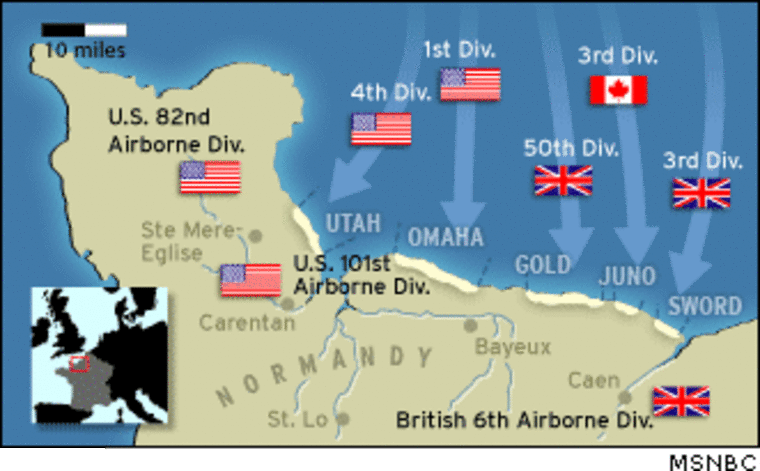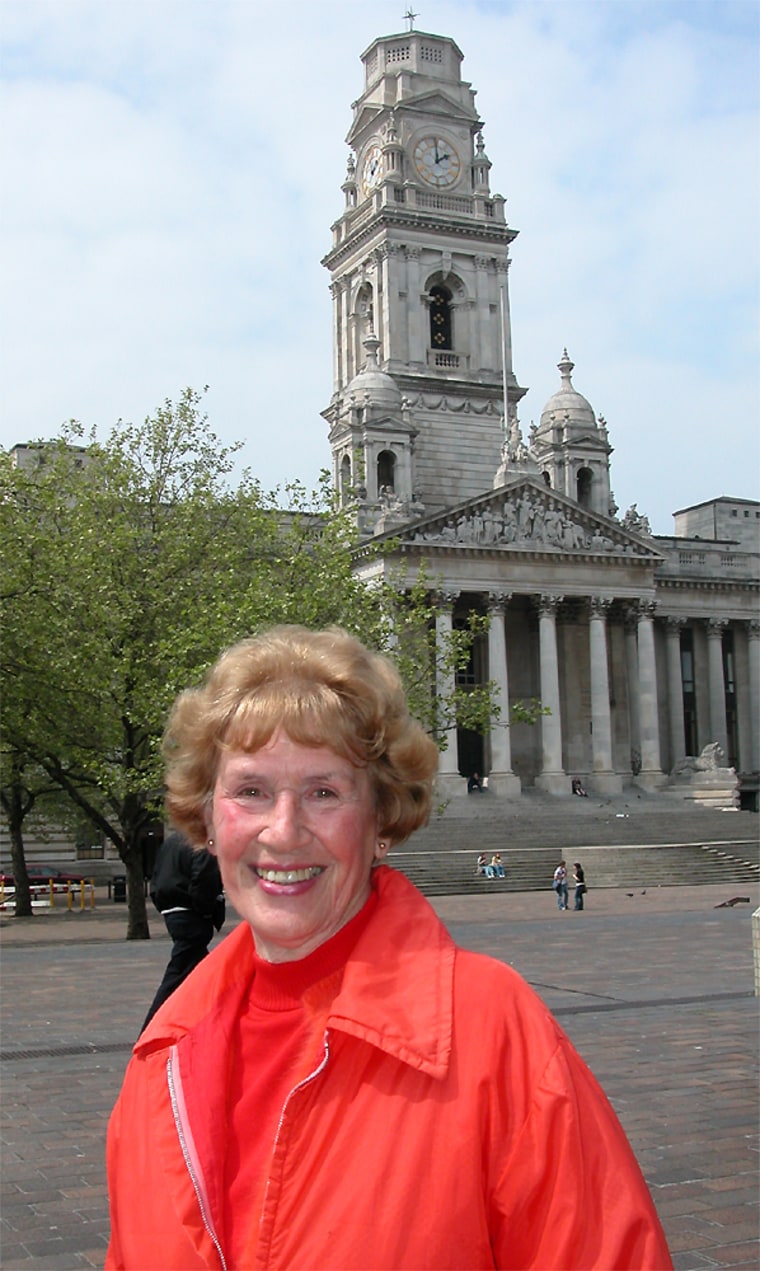“They called it the ‘Stricken City.’ Almost the whole place was razed to the ground — just flattened in every direction because the naval and shipping dockyards were here,” Moreen James said, recalling the World War II bombardment of Portsmouth, on England’s southeast coast.
To commemorate the 60th anniversary of the June 6, 1944, D-Day invasion of the French coast of Normandy, thousands will be traveling to this seaside city this week to retrace the steps of the more than 156,000 troops who crossed the English Channel from here, surprising the Germans and reversing the tide of World War II.
James, who served in the Women’s Royal Naval Service (WRENS) recently recounted her memories of what became the greatest invasion of the 20th century.
As she got off her bus in Portsmouth early on June 6, the sky was crowded with planes and gliders. "The sky was full — it was quite a fantastic site. Down in the plotting room they said ‘It’s started,” James said, recounting the moment she realized the invasion had begun.
Family duty
Sitting in the reconstructed interior of Portsmouth’s Guildhall, which retains its 1890 façade despite having been gutted in a 1945 German raid, James, 78, looked back over the decades, recalling her impatience to serve her country.
“I was afraid the war would end before I could join the WRENS,” she said. “My mom was in the WRENS in World War One, and my dad, gran, and great gran were all in the Navy,” she said, lamenting the fact that she could not sign up for service until she turned 17 and a half, on Dec. 12, 1943.
In 1939, fewer than five million women were working in Britain, two million of whom worked in domestic services.
But the war led to a dramatic shift in labor demographics, even if the women who flocked to serve their country, in Britain as well as the United States, are rarely afforded as much recognition for their sacrifices.
In Britain, tens of thousands of women served by joining the Air Transport Auxiliary, Auxiliary Transport Service, Women’s Auxiliary Ferrying Squadron, Women's Land Army, and the Women's Royal Voluntary Service.
Within the WRENS, enrollment reached its peak with 74,620 women enlisted in 1944. During the war, 102 WRENS were killed and 22 wounded.
Bomb-proof shelter
Prior to enlisting, James lived in London’s West End and worked as a nurse’s aid at University College Hospital, where hundreds of civilians were treated for injuries sustained in the German attacks on the capital.
Called to duty in March 1943, she was sent to Portsmouth for two weeks of probational training.
“You had two weeks, and if you didn’t fit in or didn’t like it you could leave because they only wanted people who really wanted to be there,” she said.
“I signed on for three years. My brother was a radio operator and plotter so I asked to be a plotter.” Naval plotters helped the military planners by keeping track of all the ships, friendly or otherwise, in the English Channel.
James was assigned to Fort Southwick, one of four Victorian forts built on Portsdown Hill in 1860 to protect Portsmouth from Britain’s then-enemy, France.
During World War II, a combined headquarters for Operation Overlord, the code-name for the Allied invasion of northwest Europe, was constructed beneath the fort, providing a bombproof Naval, Army, and Air Force Operation Control and Communication Center.
“It was built so well I think it could have withstood an atom bomb,” James said.
Living with other WRENS in a large, country house taken over by the Navy, she worked round-the-clock shifts at the fort. Descending the spiral staircase that led to a mile of secret tunnels, hidden more than 100 feet below ground, became routine for her.
Once in the plotting room, “we would put on the headphones, listen for the ships’ plots coming from the radar station on the Isle of Wight, and we’d move the blocks on the plotting table.”
“The officers knew what ship should be in what area, but if the radar station gave an unknown blip we were worried it could be a U-Boat (abbreviation for Unterseeboot, or German submarine).”
Desiring adventure, James also volunteered to serve in Malta and in the Far East. But, “there’s a standing joke that if you volunteered you didn’t get it,” she said.
Nerve-center for Operation Overlord
Portsmouth was the nerve-center for Operation Overlord, with Southwick House, just north of the city (at a separate location from Fort Southwick) chosen as Supreme Allied Commander General Dwight Eisenhower’s headquarters.
The naval city was the main departure point for military units destined to land on the beach in Normandy code-named Sword Beach, with the other units poised for the invasion at numerous areas nearby, along England’s south coast.
To deter Adolf Hitler and Erwin Rommel — the German field marshal appointed to defend the French coastline — from recognizing the build-up across the channel from Normandy, the Allies created a phantom army at Dover.
Dover is situated at the English Channel’s shortest crossing point, across from Pas de Calais, in France, and would have been the easiest, but most obvious, place to launch the invasion.

Using thousands of mock tanks and other armaments, as well as false radio and airborne radar signals, the Allies effectively deceived the Germans.
Despite the great mass of ships, landing craft, and troops in Portsmouth, none of the city’s inhabitants leaked intelligence on the invasion. The Southsea seafront had been declared a restricted zone in August 1943 and Portsmouth was closed to all visitors in April 1944.
While the people of Portsmouth knew that something was brewing, they had no idea exactly what.
‘Plots everywhere’
“When I saw that plotting table I thought ‘Oh my gosh,’” James said, recalling the moment she laid eyes on the table on D-Day.
“There were plots everywhere. We plotted all the shipping in and out of Portsmouth, all those who were bombarding the French coast.”
On June 5, 1944, after a 24-hour delay due to bad weather, General Eisenhower gave the go-ahead for the invasion of Normandy’s beaches to begin the following day. Within hours, 3,000 landing craft, 2,500 other ships, and 500 naval vessels crossed the English Channel.

Parachutists and gliders landed in Normandy, and by the time James got to the plotting table on June 6, the first wave of the 156,000 troops to disembark on the French coast that day had already landed at the beaches codenamed Omaha, Utah, Gold, Juno, and Sword.
“At the time you knew something fantastic was happening, but you didn’t really stop and concentrate on it because you had a job to do. You knew it was an invasion and that was it,” she said.
When everyone is “working for one goal,” no-one has time to indulge in their personal thoughts or concerns, she said, using her worst memory of the war as an example.
“My brother was on the HMS Arathusa which was one of the ships bombing the French coast (prior to the invasions),” she said.
“I had plotted his ship out at 1 p.m., and when I came back on duty at 8 a.m. the next day I saw the HMS Arathusa had a direct hit.”
Despite her fears, James completed her shift as usual, and only asked an officer afterward if her brother “was among the casualties.” Fortunately, he was not.
Speaking about D-Day, she said “it really only hit you sometime later just how important it was. If you started thinking of the thousands of men who would be killed you wouldn’t have been able to do your job.”
On D-Day alone, the Allies suffered an estimated 10,000 casualties, including 2,500 killed in action.
'Wonderful atmosphere'
After the war ended in Europe, James signed on for another three years in the WRENS transport division, married a WWII Army veteran in 1949, and later worked as a guide at Portsmouth's Guildhall for 22 years.
"I can look back because I didn't lose any family; I consider myself very lucky," she said.
Despite the obvious hardships, James noted that the war also had positive effects on society as individuals banded together in their common struggle.
“If there were people a couple houses up the road that got blitzed and lost everything, people took them into their house and gave them what they had," she said. "Everybody shared everything."
Sixty years after the D-Day invasion, "the world is young peoples' oyster, but I don’t think they will ever have that wonderful atmosphere of people all pulling together towards an end," she said.
"I don't feel that I lost anything (due to the war). Because of the wonderful atmosphere, and the kindness of people, I think I got more out of life."
